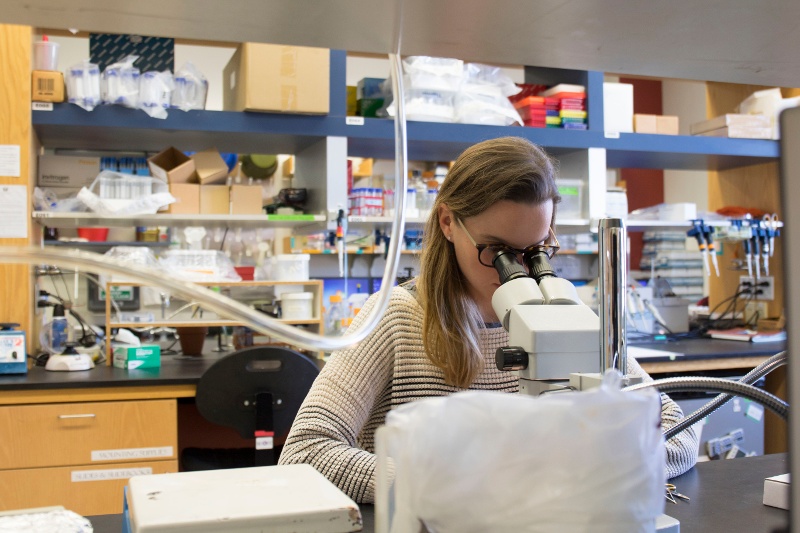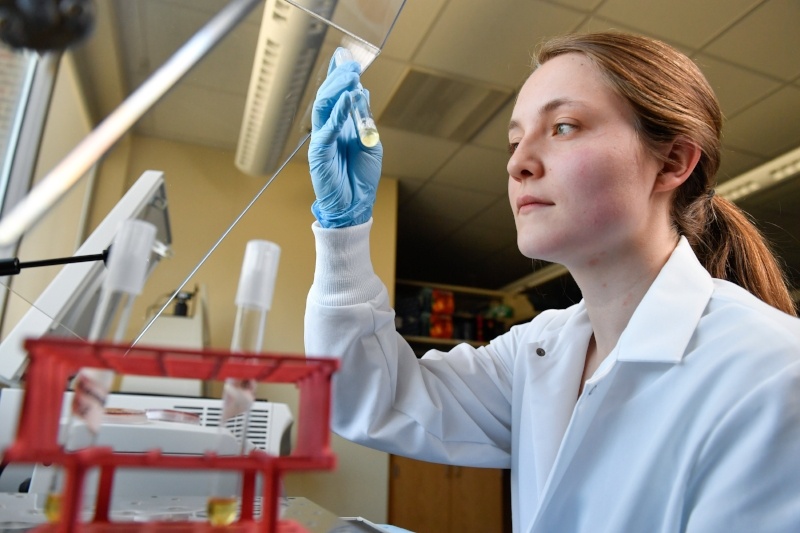
Kristyn Lizbinski, a doctoral student studying biology at West Virginia University, is on a mission to reveal that every neuron is a unique snowflake. In more technical terms, she's researching the principles of neuron diversity.
Keep reading for a closer look at Kristyn's research findings, along with how she utilized WVU's status as one of the 120 R1 institutions in the nation to augment her STEM education.
Tell me a little bit about yourself!
I’m Kristyn Lizbinski, 27. I grew up in small, woodsy town called Drums, in the Northeastern region of Pennsylvania.
I completed my undergraduate degrees at the University of Scranton in Scranton, PA (famous for the wonderful show ‘The Office’). I double majored in Neuroscience and Philosophy.

I was also fortunate to work in a research lab at the University of Scranton studying the neuroanatomy of ants. This experience piqued my interest in pursuing a Ph.D. I didn’t pursue a master’s degree but rather went straight into the Ph.D. program in the Department of Biology at WVU.
What specifically are you studying in the Department of Biology?
I’m enrolled in the Ph.D. program in the Department of Biology in the Eberly College of Arts and Sciences and work in the lab of Dr. Andrew Dacks. In the first few years of the program, I took courses on the function and mechanisms of nervous system function, and I also had the opportunity to teach. Teaching helped solidify my understanding and passion for science and was a great opportunity to hone my communication skills.
In the lab, I research how brains make flexible computations based on an animal’s current needs. For example, we perceive the odor of food differently when we are hungry vs. full. Our brains are able to alter our perception based on our needs, or internal physiological state. One way brains do this is through a process called neuromodulation, which allows individual neurons and networks of neurons to alter how they communicate with each other. I study neuromodulation using the brain of the moth, Manduca sexta. Where human brains have billions of neurons, the part of the moth’s brain I study contains around a thousand neurons and in large part uses many of the same neuromodulators that our brains use, such as serotonin and dopamine. These similarities allow me to determine conserved mechanisms and important processes by which nervous systems flexibly tune their output to drive context-specific behavioral responses.
Tell me about your graduate assistantship experience.
Yes, during the semesters I didn’t teach, I was lucky to be granted a graduate assistantship. My responsibilities were very similar to my day to day research responsibilities for my dissertation project. I performed experiments, read papers, and analyzed data, which all went towards eventual publications of my work.
Tell me about your research discussed here.
In order to understand how our own brain works, we need to understand how diverse groups of neurons coordinate their activity to result in behavior. To do this, we must determine the consistency with which neurons release one or more chemicals called neurotransmitters.
We can think of each neurotransmitter like a tool for changing the brain’s activity in a certain way; the presence of more than one tool allows a neuron to change brain activity in different ways. I found a group of neurons in the moth that are highly diverse in terms of the number of neurotransmitters they release, essentially expanding the roles they play in the network. I then used computational modeling to try to find the organizational rules that dictate which neurons possess specific combinations of tools. This gave us a road map of all of the neurons that express each neurotransmitter, and therefore provided clues into each neuron’s function in the brain.
This project was one of three chapters of my dissertation and was an interesting way to combine anatomical and computational aspects of neuroscience. My other work focuses on how specific neuromodulators like serotonin and dopamine physiologically alter neurons’ responses to sensory stimuli, specifically odor/olfactory information.
Tell me about one faculty member who really made a difference in your education at WVU.
My advisor, Andrew Dacks, has been formative in my growth as a scientist during my time at WVU. His enthusiasm and creativity has shaped how I think about scientific problems, and his encouragement has helped me achieve my goals for my continued path in science.
Why do you think pursuing an advanced degree in a STEM field is important for people who want to promote innovation in your field?
Pursuing an advanced STEM education allowed me to contribute my small piece of knowledge to the larger puzzle of understanding brain function. For me, the biggest lesson in pursuing an advanced degree in STEM was learning how to fail gracefully. I learned the most when experiments didn’t work, and sometimes failing allowed me to really understand the ‘how’ of each process and experiment.
I think it’s important to remember that innovation doesn’t happen overnight. Advances in science are driven by the collective work of creative and diverse minds striving to solve basic and applied research questions. Being a part of this broader collective has been challenging, rewarding, and exciting.
Finally, much of our mechanistic understanding of the brain was first discovered answering basic research questions in invertebrate organisms. ‘Basic’ doesn’t imply the work is simpler, but rather it is research not directly focused on curing human disease. For example, the action potential, the central unit of neural communication, was discovered using the nervous system of a squid. Ultimately, basic neuroscience research identifies the fundamental puzzle pieces of healthy nervous system function so applied research can determine how to fix the pieces when they are broken.
New students in STEM dedicated to both basic and applied research, as well as continued, strong funding of both avenues will be central to advancing science and medicine.
What are your plans after graduating this December?
I’ll be starting a position as a Postdoctoral Research Associate at Yale University School of Medicine in the lab of Dr. James Jeanne. I’m grateful for the opportunity to continue investigating how nervous systems tune their output based on the current needs of the animal.
Lastly, what’s your favorite thing about WVU?
The people. I’ve been very lucky to be a part of a supportive lab environment which laid the foundation for my future in science.
WVU is dedicated to meaningful research.
Are you interested in learning more? If so, we hope you'll request more information today! Also, if you have questions about the below topics, we have resources to help you there too!
- Securing a graduate assistantship
- Pursuing an advanced STEM education
- Choosing a graduate school
- Financing graduate school
- GRE test prep
- Making a career change
- Enrolling in graduate school online
- The value of R1 institutions
Explore the importance of research and the value of R1 institutions with our digital resource page — A Guide to Research-Based Graduate Programs at West Virginia University!


-489630-edited.jpg)






